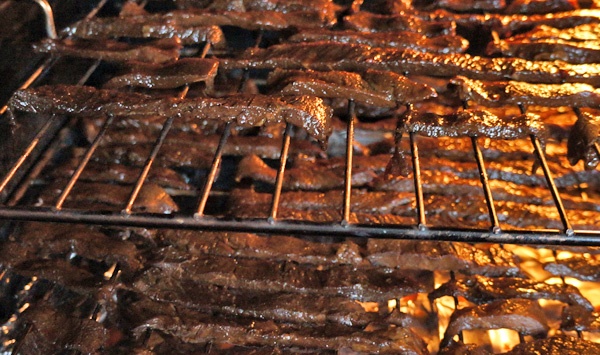However don’t get the wrong impression, I don’t think knowing how to dehydrating meat into beef jerky is some critical life skill. I not a fan of saying anything is the best, because you assume you know what perfection is. The thing about perfection is that it’s unknowable. It’s impossible, but it’s also right in front of us all the time. It’s something so delicate or precise that it becomes difficult to analyze or describe what just makes something, or someone, truly great. I hope we can slow down with our exaggerations, reserve tall-tales for only the people that were unanimously great, and build a understanding between all of us so that we can create truly wonderful things together.
Despite what it may seem, I do think that the recipe makes some good beef jerky, and it is definitely something to talk about and share with friends and family. However, that claim of being the worlds best… well, I’m more particular to a piece that I got from a vendor years ago right next to the “Mud Show” at the Bristol Renaissance Fair. It could be argued that it was the moment and not the food, but I think that argument is a flawed because I feel that all we have in life to going on is our own experiences and nothing more.
I wasn’t able to prepare the meat in the fifteen minutes that the recipe suggest and I feel that it should call for more time. However the point of making beef jerky isn’t reliant on speed or simplicity. The point of making beef jerky is to have great tasting food that lasts a long time despite warm temperatures, no preservatives, and a sterile environment. When I was making my first batch I didn’t have any sesame seeds and made the beef jerky with out sesame seeds which I feel is for the better. Otherwise I was spot on while adjusting for the different amount of meat that I had. Finally, I’m made some small adjustments to the recipe to what I think is a better tasting, better proportion control, and better expectations.
Beef Jerky 001
My personal rating is 4.0 stars
- 3lb of Lean Beef
- 3/4 cup of Kikkoman Soy Sauce
- 3/4 cup of Worcestershire Sauce
- 3/4 cup of thick Teriyaki Sauce
- 1/2 cup of Liquid Smoke
- 1/2 cup of Blackstrap Molasses
- 11/2 Teaspoon of Garlic Powder
- 11/2 Teaspoon of Onion Powder
- 11/2 Teaspoon of Brown Sugar
- 1/2 Teaspoon Cayenne Pepper (Use another 1/2Teaspoon if you would like some kick)
- Put the meat in the freezer for an hour to make slicing easier. Slice meat with the grain as close at you can to 1/4″ strips. The leaner the meat, the better and longer-lasting the jerky.
- In a large container, mix the Soy Sauce, Worcestershire Sauce, Teriyaki Sauce, liquid Smoke, and Blackstrap Molasses.
- Add the Garlic powder, Onion Powder,
Sesame Seeds, Brown Sugar, and Cayenne Pepper. - Stir well, then drop your meat into the marinade. Your meat should be fully submerged.
- Close or cover the container(s), then leave in the refrigerator for 24 hours. I had to cut it short at 18 hours.
- Cover the bottom of your oven with aluminum foil. Things will get messy.
- Place the meat on the racks of your oven, one next to the other (see the picture).
- Set your oven temperature to 160°F or 180°F if you’re in a rush. Crack open the oven door by sticking a wooden or plastic serving spoon in the top of the door. If you have a convection oven, turn the fan on too.
- Let it dry for 3 hours, then turn over the jerky. After another 3 hours, it should be done. The total time, however, is dependent on the thickness of the meat and the temperature of the oven. The jerky is done when it’s dry enough that you can rip off a piece easily, but before it snaps when you bend it. (I have convection oven so it only took 2 hours.)
- Leave meat out in the air to cool. It is now ready to eat. The longer you leave it out to cool, the drier it will get. After, but no longer than 24 hours, store it in sealed Ziploc bags. Without refrigeration, it will be good for 4–6 months.
Enjoy!





Leave a Reply